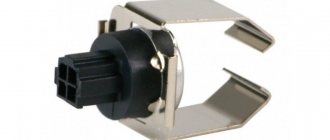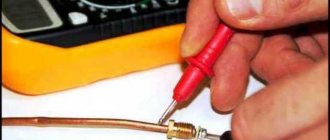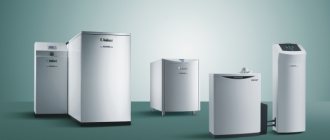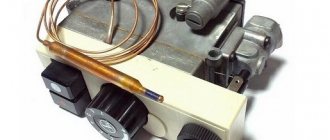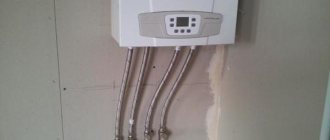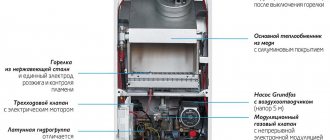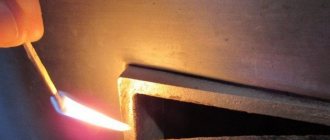Home » Automation and controls » Connecting an external temperature sensor for gas boilers
The industry produces many different programmers that control the operation of heating equipment depending on the temperature outside or indoors. The most practical are external temperature sensors for gas boilers. They regulate the operation of the unit depending on the conditions outside, which allows you to quickly and clearly adapt to weather changes.
…
- 1 Temperature sensor device
- 2 How to install the outside temperature sensor correctly?
- 3 Connecting and setting up the outdoor temperature sensor
Purpose and design of the temperature sensor
At the manufacturing plant, the automatic gas boiler is configured to operate at the lowest ambient air temperatures, but the outside temperature can change daily. You have to constantly adjust the operation of your heating equipment. To avoid performing this process manually, the outdoor temperature sensor of the boiler is connected.
The temperature sensor allows you to regulate the heating of the coolant depending on the outside air temperature. Thanks to this, the boiler will operate periodically and not constantly. This mode of operation will lead to gas savings and a reduction in heating costs.
In most cases, the device has a simple design. It includes:
- The sensor itself;
- Terminals for clamping electrical cables;
- Cable sleeve;
- All these parts are housed in a plastic case.
KromSchroder AFS.
Advantages of temperature sensors for gas boilers on piramida24.ru
The popularity of gas boilers for individual heating and hot water supply of private houses and cottages in Russia is explained by the more affordable cost of gas compared to other types of energy resources, which causes an increased demand for spare parts for this equipment. The sensor for a gas boiler is one of the rather popular spare parts, since it operates under constant influence of high temperatures and an aggressive environment (submersible sensors). If this important element fails, you need to buy a sensor for the boiler that is absolutely identical to the one provided by the design of your gas boiler.
The Pyramida24 online store offers a wide selection of sensors for gas boilers of most brands used in Russia, including Ariston and Bosch, Baxi and Ferroli, Vaillant and others. We offer our clients:
- wide range of sensors;
- comfortable purchasing conditions;
- providing a guarantee for the purchased product;
- consulting support from experienced specialists on the selection of spare parts suitable for a specific gas boiler model;
- possibility of payment in a convenient way.
We sell only original sensors and their high-quality analogues from trusted manufacturers. You can buy temperature sensors for boilers on piramida24.ru at an exclusive price with fast delivery throughout Rostov-on-Don and Russia. Call us or place an order in the online form on the website!
Installing a temperature sensor
The outside temperature sensor for the boiler is installed on the wall of the building on the street side. The following requirements must be met during installation:
- Avoid exposing the temperature sensor to direct sunlight. Installation should be carried out on a wall facing north or northeast;
- It is not recommended to install on surfaces affected by mold or places where there is high humidity;
- It is prohibited to install the outdoor air temperature sensor on a metal surface, because metal structures have low thermal insulation;
- The operation of the device should not be influenced by extraneous factors. It is prohibited to install it near a chimney, ventilation, door or other potential heat sources that could increase the air temperature near the device;
- If installation is carried out on the wall of a building with a height of no more than 3 floors, then the installation should be carried out at a level of 2/3 of its height. If the house is higher, work is carried out between the second and third floors. For installation, it is recommended to choose a flat surface and fasten the device using anchor bolts.
Classification of types of temperature sensors
The choice of sensor depends on the environment in which the temperature needs to be monitored: inside the boiler, in the room or in the heating system. The efficiency and safety of heating equipment depends on the correct choice.
The temperature sensor for a heating boiler is classified according to the following criteria:
- by the method of determining temperature,
- by type of interaction with the thermostat.
Types of sensors by method of determining temperature
According to the method of determining temperature, sensors are:
- Dilatometric, which are bimetallic plates or spirals, the operating principle of which is based on the thermal expansion of metals or other types of solids.
- Resistive, having a strong dependence on temperature in a certain measured range, which manifests itself in the form of sharp changes in electrical resistance.
- Thermoelectric, which are thermocouples (alloys of two dissimilar conductors, for example, chromel-alumel), in which thermo-EMF begins to induce at certain temperature intervals.
- Manometric, the principle of operation of which is based on changing the pressure of a gas or liquid in a closed volume.
Dilatometric sensors are made from materials with a high coefficient of thermal expansion that respond to minimal temperature fluctuations. The principle of their operation is based on the closing or opening of electrical contacts. To increase their sensitivity and quality of contact, magnets are used in structures.
Resistive temperature sensors are made from special alloys of conductors or semiconductors. Structurally, they consist of a coil with a wound thin copper, platinum or nickel wire and a ceramic housing or semiconductor wafers placed in a plastic or glass housing.
Semiconductor resistors come in two types:
- thermistors having a nonlinear temperature dependence, characterized by a decrease in resistance when heated,
- posistors, which also have a nonlinear dependence on temperature, but differ from thermistors by increasing resistance when heated.
Thermoelectric sensors are made of two specially selected dissimilar metals or alloys, at the point of contact of which, when heated, a thermo-emf is induced, the value of which is proportional to the temperature difference between the two junctions. In this case, the measured value does not depend on temperature, length and cross-section of wires.
Gauge sensors allow you to determine temperature in a non-magnetic way without the use of energy sources, which allows them to be used for remote measurements. However, their sensitivity is an order of magnitude worse than that of other temperature sensors, and there is also an inertia effect.
Types of sensors according to the method of interaction with the thermostat
Temperature meters based on the type of interaction with the thermostat are divided into the following types:
- wired, transmitting data to the controller via wires,
- wireless – high-tech modern devices that transmit data at a certain radio frequency.
Wired temperature sensor for boiler
Mounting the temperature sensor on the wall
Wall mounting.
In order to gain access to the mounting holes and terminal block, you need to unscrew the protective plastic cover. Once the location where the temperature sensor will be placed is determined, the centers of the mounting holes are marked. Next, unscrew the nut designed to seal the cable. After this, two wires are connected to the sensor. At the final stage, the sealing nut is tightened and the housing cover is closed.
Connection
Typically, temperature sensors are located in the thermostat housing. Therefore, when considering connecting a temperature sensor, in most cases we mean a thermostat, and not a separate sensor.
Outdoor
The outdoor device is attached to the wall on the north or northeast side of the building. The electrical connection is made with a 2-core copper wire with a cross-section of 0.75 mm² and a length of ≤ 30 m; a wireless device can be installed. One side of the wire is connected to the sensor contacts, the other is connected to 2 terminals of the electronic board, between which a TA jumper is screwed. The jumper must be removed before connecting.
Indoor
The room sensor is installed in the coldest or corner room of the building, where household members are usually located, to avoid giving false signals. The voltage coming from the electronic board to the thermistor does not exceed 24 V. Therefore, laying a low-current cable with a cross-section of 0.2–0.35 mm² to the boiler is possible if the length of the wire does not exceed several meters. The connection is made in the same way as the connection from an external sensor.
For gas boiler
On the thermostat block with a temperature sensor, you should find contacts marked COM (common) and NO (normally open) and connect two wires to them on one side of the cable. Using the heating unit connection diagram on the control board, find 2 terminals with a jumper from a piece of wire to connect the thermostat. Remove the jumper and connect the free contacts to the 2 cores on the reverse side of the cable.
Water temperature sensor
In a similar way, the water floor cable is connected to the boiler terminals, and a small-format device is attached to the reverse side. The water temperature sensor is placed in the floor at an equal distance from the coolant pipes, the distance from the nearest wall is 0.5 meters.
Connecting an outdoor temperature sensor
Electrical connection.
Important! Before connecting the sensor, you must turn off the power to the boiler.
For connection, a solid cable of 2 * 0.5 mm, no more than 30 m long, without any connections, is used. It must be laid through a hole in the wall to the gas boiler, where it is connected without observing polarity to its terminal block. Also during installation, a sealed sleeve is used to insulate the cable.
How to choose a temperature sensor
DT are the main elements of automatic safety and regulation of any boiler. Their selection is made by the manufacturer as part of the unit protection system. Nevertheless, there are situations when you need to do this yourself, for example, when reconstructing the heating supply circuit of a house or installing an additional indirect water heating boiler into the circuit.
The selection of a temperature sensor for a gas boiler is carried out taking into account the following indicators:
- The DT must be sensitive in operating temperature ranges and record all changes in the heated medium with the least delay, at high temperatures, for example, as in the furnace of a boiler;
- take into account the specifics of the controlled environment and technological features of installation: submerged or fixed to the body;
- take into account all negative influencing factors and, if possible, minimize them;
- take into account the design features of the DT: voltage, speed of the transmitting signal, permissible errors in measurements, areas of application, maximum service life, the need for periodic inspection and certification of the device.
At the same time, when choosing a diesel engine, you need to carefully read the instructions and connection diagram so that the requirements match the equipment already installed on the boiler.
As a rule, you should order meters recommended by the boiler manufacturer to ensure compatibility of safety system elements and guarantee their error-free operation. In cases where such modifications are not available in the retail chain, you should choose from certified analogues.
Features of operation
In order to obtain a metrological characteristic with a given error and develop the service life of the device, it is necessary:
- periodically (at least 2 times a year) check the technical condition of temperature sensors;
- within the time limits specified by the manufacturer in the accompanying documentation for the product item, carry out installation-free or laboratory verification of the thermoelement;
- pay attention to the correct connection of the terminals of the device with the power element (unit) and the connected secondary circuits on the boiler;
- when determining the connection terminals on the electronic board, check the correspondence of the contact markings with a multimeter in dialing mode;
- do not open, protect the device from strong impacts, extreme temperatures and high pressure.
